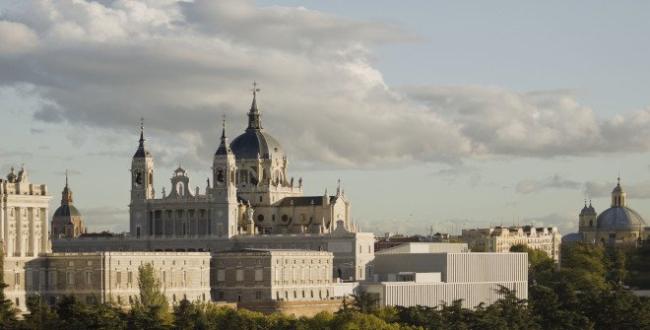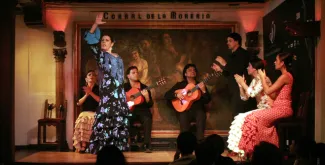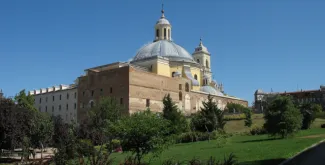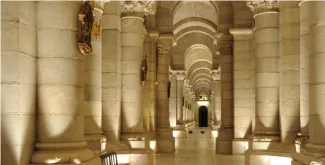Gallery of Royal Collections
Information
OPENING IN SUMMER 2023
Built in Madrid’s Royal Palace complex, finishing off the cornice that opens on to the Campo del Moro gardens from Plaza de la Almudena, this museum will offer a journey through the history of the Spanish Monarchy and the artistic taste of each of its important figures, from the first reigns of the Middle Ages to Juan Carlos I.
Once inaugurated, in summer 2023, the museum will be the main tool for the projection of National Heritage’s cultural activity and a stage for the enormous wealth and diversity of the Royal Collections related to this body. It will also become the backbone of the visit to the Royal Palace complex, whereby it can be accessed from Plaza de la Almudena and from the Campo de Moro and Madrid Río gardens.
The origins of the museum date back to 1935, during the 2nd Republic, when its construction project was commenced. However, this attempt was thwarted by the outbreak of the Civil War in 1936. In 1998, the idea was taken up again and the construction of the centre was approved. The works began in 2006 and were carried out in four phases until 2015. The building has won several architecture awards, of which the COAM 2016 First Prize and the FAD Award for Architecture 2017 stand out.

The building has a total area of 40 475 m2 spread over six floors, housing three exhibition rooms with heights ranging from six to eight metres, a reception room for works of art, six storage rooms, offices, as well as spaces for technical installations, among other facilities. It is designed to achieve maximum energy savings.
Of the six floors, -3 is the largest (over 3500 m2) located on the lowest level of the building, followed by floors -2 and -1, spread over 3000 m2 each. Floor 0, with 2269 m2, has the main access to the museum. Floors 1 and 2 are smaller in size. The museum therefore has more than 3200 m2 destined for the permanent exhibition and more than 1300 m2 for temporary exhibitions.
A linear model has been chosen for this museum, with a main descending route, which begins in the access located between the Royal Palace, Almudena Cathedral, and the museum itself, and finishes on floor -3, by the Campo del Moro gardens. Its exhibition dialogue will be under constant transformation: a third of the pieces will be constantly rotated.
The building will also have a cafeteria and a space for educational workshops. There will be two entrances in the Plaza de la Almudena (next to the Mirador de la Cornisa, a viewing point that offers stunning views over the Campo del Moro gardens, and Casa de Campo) and on the Cuesta de la Vega, and it will be connected directly to Madrid Rio (through the Bonaparte tunnel – currently closed –), Plaza de España, and Calle Mayor.
A journey through the Gallery
After entering via Plaza de la Almudena, the exhibition in the first hall (Level -1) starts with the Catholic Monarchs. The tapestry collections and the Royal Armoury will enter into dialogue with works by Bosch, Titian, El Greco, Ribera, Velázquez and Caravaggio, among others. The Royal Monasteries as female spaces of power and patronage will also take centre stage. This floor has a privileged window on the origins of Madrid: the 9th century wall discovered during the construction of the building, which is also explained in an audiovisual presentation.
Level -2 starts with the plans of the new Royal Palace in Madrid, commissioned by Felipe V after the fire at the Alcázar, and will be rounded off with Tuñón and Mansilla’s model of the Royal Collections Gallery. The musical instruments, furniture and decorative arts will coexist with Mengs, Goya, Tiépolo, Paret and Maella. The final section includes photography and explains how the State assumed the conservation of the Royal Collections and the opening of the Royal Sites to the public through National Heritage, a body that was created in the 2nd Republic.
Level -3 (which can also be accessed from Campo del Moro) can be defined as the 21st century floor. An immersive cube has been set up here, in which 360º images of architectural and natural spaces at diverse Royal Sites will be screened. The temporary exhibition hall will also be on this floor.
Docking stations:
- Palacio de Oriente (calle Carlos III, 1)
- Plaza de Ramales
- San Quintín (calle Pavía, 6)
- Segovia 26 (calle Segovia, 26)
To be confirmed
IN THE AREA

Corral de la Morería

Basilica of San Francisco El Grande

Madrid Río Park

Crypt of La Almudena Cathedral
The oldest part of Madrid combines the majestic Royal Palace with the popular atmosphere of Plaza Mayor and surroundings








